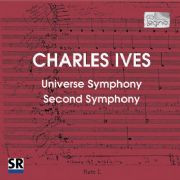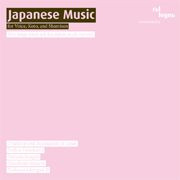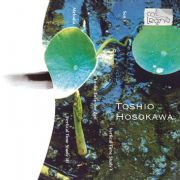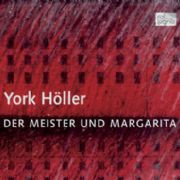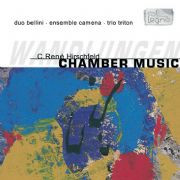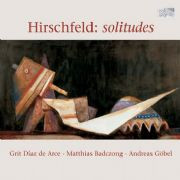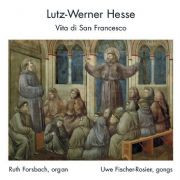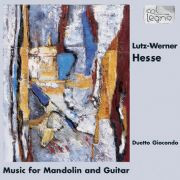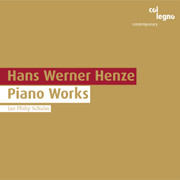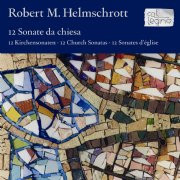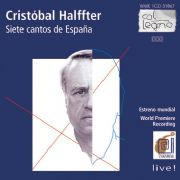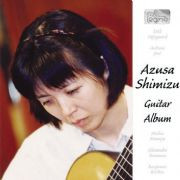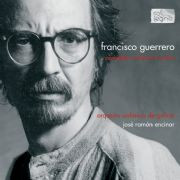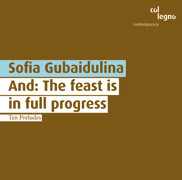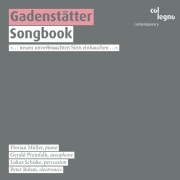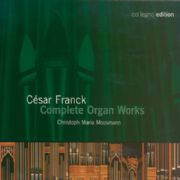★Col Legno
Universe Symphony / Second Symphony
The most ambitious and grandest of his projects would of course never see completion. For over forty years, Ives continued to supplement the material for his Universe Symphony, adding both notes and details. At some point, the scenario he envisaged got somewhat out of hand, Henry Cowell reported. “Several orchestras and large parties of singers, male and female, were to be placed in valleys, on mountain slopes and on summits,” and “6 to 10 different orchestras on several mountain tops, each movi…
Music For Voice, Koto And Shamisen
As part of its Japan focus the 1999 Biennial Festival for New Music in Hannover also presented Toshio Hosokawa's exploration into the music of his "musical ancestors." This CD was recorded live during the performance and includes three works from the 17th and 19th centuries. Chidori no kyoku by Yoshizawa kengyô II (1808-1872) is based on the 31-syllable poems of the classical poetry anthology Kokin wakashû (10th century), so-called waka poems; chidori is the Japanese plover, whose calls have bee…
Vertical Time Study I / Sen V / In die Tiefe der Zeit / Melodia
In his series Vertical Time Study, Hosokawa seeks to „integrate Noh’s vertical structure of time into my own music. It is about how temporal elements, like wedges, disrupt the vertical, horizontal timeline at irregular intervals. These disruptions produce elements of tension … creating visible fissures in the structure of time and visible cracks in space. My aim is to examine the complexity and the depth of these sounds hidden in the moment.” In his piece Sen V, Hosokawa tries to combine the “ea…
Der Meister und Margarita
It is in itself a brilliant achievement to transform this complex religious-philosophical satirical novel from 1930s Moscow into a spellbinding opera. And each setting is imbued with its very special local color, whether it's Satan's ball, the asylum, the evil apartment, or the Place of the Skull: "Höller underpins, surrounds, conveys or impedes the sung and spoken parts by a dramatic theater music of powerful images and driving force, making use of the orchestral range of sounds both moderately…
Chamber Music
“Art can give us a sense of the infinity of existence, the singular unity of all beings and phenomena as the apparent dualism between the inner and the outer is dissolved. Art can allow us to experience what it means to be alive. It can lead us back to our own sensuality, spirituality, and emotionality - to the very core of our selves,” said Caspar René Hirschfeld. This distinctive conception of art also informs Hirschfeld’s compositions, which are probably best described as objects of immediate…
Solitudes
Hirschfeld deliberately distinguished solitude, or loneliness, from a state that leads to depression or despair. For him, the contemplation of one’s self leads to the “dialogue with one self and with nature”, as is the case, e.g., in his Chant of the Night, which is based on poems by Walt Whitman. Hirschfeld chose Whitman’s Leaves of Grass with its portrayal of human solitude in the plains as a starting point in order to develop the music from a simple melodic cell, “which, like human consciousn…
Vita di San Francesco
When, in the summer of 1992, Lutz-Werner Hesse visited St. Francis’s hometown in Umbria, he was deeply moved by Giotto’s frescos in the Basilica. Using prints of the frescos, Hesse later developed a dramatic sequence, which was meant to serve as the basis for a composition revolving around the life of the saint. Gongs had always held a special fascination for Hesse. So, for this piece, he pitted 13 gongs against one organ: “The organ, I thought, is a particularly suitable partner for the gongs s…
Music For Mandolin And Guitar
The minor forms represented on the present recording range from the principles of the ars nova in the Sonata piccola to the weird waltzes in the Movimenti per chitarra. With the exception of the Préludes, the pieces are to be performed as cycles. The Sonata Piccola, composed in 1986 and revised in 1996, is really based on medieval compositional principles. The names of the movements of the Movimenti per chitarra and of the Partita then suggest Baroque forms of the suite. At the same time, a logi…
Piano Works
Jan Philip Schulze has been playing Henze’s piano works “in his sleep,” as he says. Indeed he has worked with the composer intensively on every piece, yet during the recording sessions he was noticeably surprised, while listening back to recordings, to find himself confronted by the work afresh, discovering new sides to it which he had previously experienced differently.
12 Sonate Da Chiesa
There is little doubt that Helmschrott’s Sonate da chiesa only bear a fleeting resemblance to their namesakes from the 17th and 18th centuries, which, emerging from Northern Italy, quickly rose to great popularity in Baroque Europe. Among the resemblances is their bipartite structure with slow and fast movement and, of course, the use of an organ. Far from expressing formal dependence, the archaic names of the movements lend the twelve pieces a Mediterranean superstructure, as it were. The manif…
Metamorphose
“Once you focus your will and mind on a particular thought or sentiment, and screen out the external world, you’re being transported into a state of contemplation, which fully takes effect in solitude: relaxation in a unity of subjective and objective experience which has come to rest.” (Robert M. Helmschrott) In the best case scenario, this basic, contemplative frame of mind helps sharpen consciousness, which, in turn, further deepens the understanding of music,” “reaching deep into the all-enc…
Cathédrale
Concert music for solo harp: The harp, whose ancestor belongs to the most ancient musical instruments, is usually associated with impressionistic sound. But Roman Haubenstock-Ramati - the most visionary inventor of sounds among contemporary composers, according to Wilhelm Sinkovicz – has never been satisfied with the status quo. So, while teaching composition and investigating new forms of musical notation, he succeeded in his endeavor to explore new possibilities of musical expression again and…
Siete Cantos De Espana
The three cultures at the center of the songs on this recording make a joint appearance in the finale of the Siete cantos de España. They are formed into a unified whole in Ensalada, as the soprano and the baritone begin singing together texts of Castilian, Sephardic and Arabic origin. The poems’ subjects are love, agony and death; and in order to bring them to life Halffter requires a large orchestra of about 100 musicians and two soloists with the baritone singing Spanish texts and the soprano…
Guitar Album
This enterprising programme of 20th century music, recorded in England by the distinguished Japanese guitarist Azusa Shimizu, contains first recordings of pieces by Højsgaard and Mamiya, as well as offering a rare opportunity to hear the sonata by Antonio José, who was brutally murdered during the Spanish Civil War. An outstanding CD for all guitar music enthusiasts.
Complete Orchestral Works
Complicated, yet not complex: In order to create music as nature makes it, Guerrero employs fractal principles of composition.
And: The feast is in full progress
The second cello concerto, entitled: Y: la fiesta está en pleno apogeo – And: The feast is in full progress (1993), is based on a poem by the Chuvash poet Gennadi Aigi. The vision of a raging mass of people awaiting the last Judgment is transformed into music by the composer with gripping, immediate, expressive force, free of graphic patterns. A moment of glory not for Gubaidulina only, but for David Geringas on cello, too. And as a bonus on this CD: Diez Preludios –Ten Preludes for Cello, in Vl…
Orchestral Works & Chamber Music
Dmitri Shostakovich was to encourage the young Gubaidulina, for instance when he told her in his official function as the chairman of a board of examiners: "Keep on composing on your errant ways." Her intuition was based on her profound religious faith as well as on literature and philosophy. In her String Trio of 1988 she accomplished a particularly impressive motif transfer in the finale. The motif, which has been powerfully completed before, sneaks in again through the first violin, endures, …
Songbook
If you'd like to hear what might remain, and might survive, of the popular common musical property, these two works by the Salzburg composer Clemens Gadenstätter will give you some essential clues. "Akkor(d/t)anz" is based on the character of Romantic piano music manifested by monumental chords. The explosion of the chord is followed by pulsations derived from differentiated perceptions of its details. The "dance" of chords in accordance with new formations of the original chord demands an energ…
Fama
Site-specific FAMA, “audio theatre piece for large ensemble, eight voices, actress, and sound structure,” requires the best performers for execution. Luckily, Furrer draws upon the talented Neue Vocalsolisten Stuttgart and Klangforum Wien. Also credited are the architect, acoustician, technical and lighting engineer, costumer and stage direction. Texts are by Ovid and Arthur Schnitzler. The focus on space and solo instruments (contrabass flute and two bass clarinets) suggest Nono’s late aestheti…
Complete Organ Works
Franck turned to writing organ music only in his thirties, prompted not least by his appointment as organist at the Parisian Basilica Ste-Clotilde in 1858, a post he held until his death. He had played the organ at smaller churches in Paris before; the Six Pièces date back to that time and his first years at Ste-Clotilde; the core piece, Prélude, Fugue et Variation op. 18, with its extraordinary structure including a fugue as the central part, is dedicated to Camille Saint-Saens. Pastorale is de…
